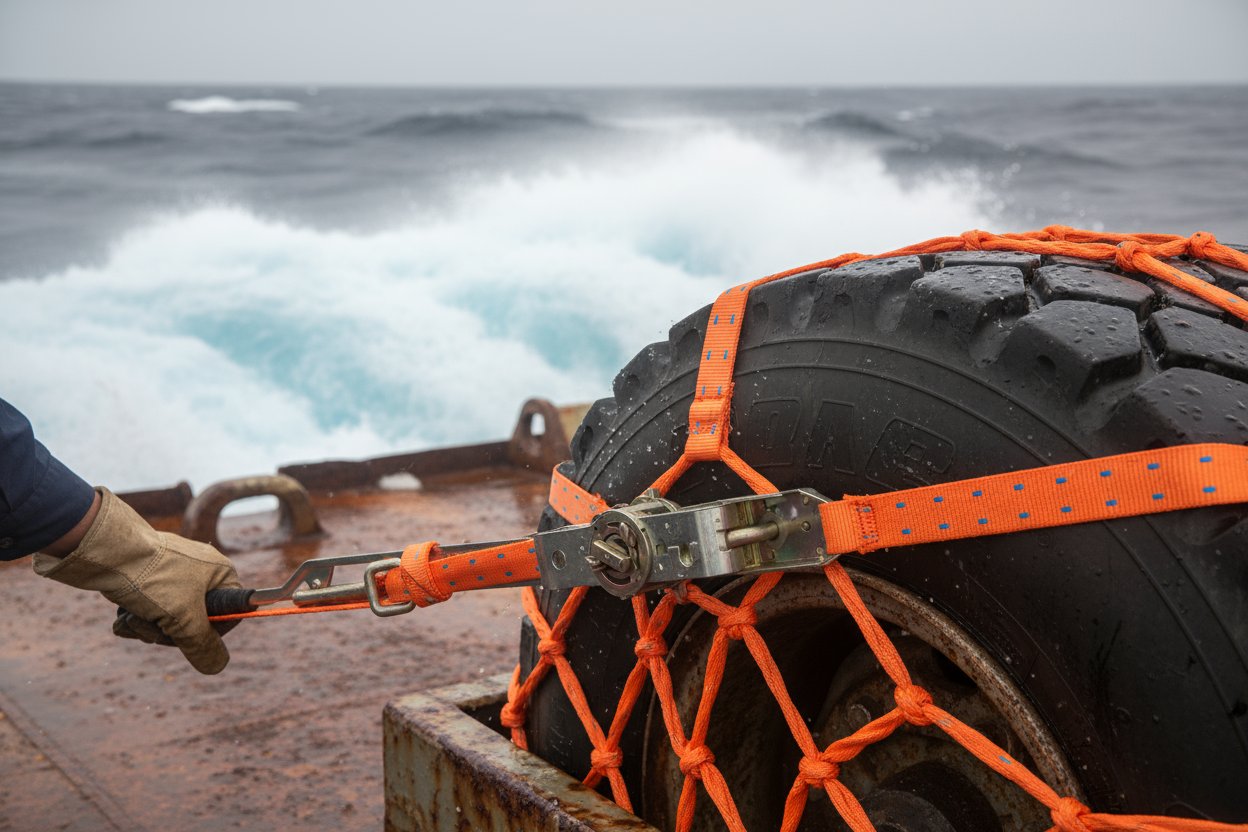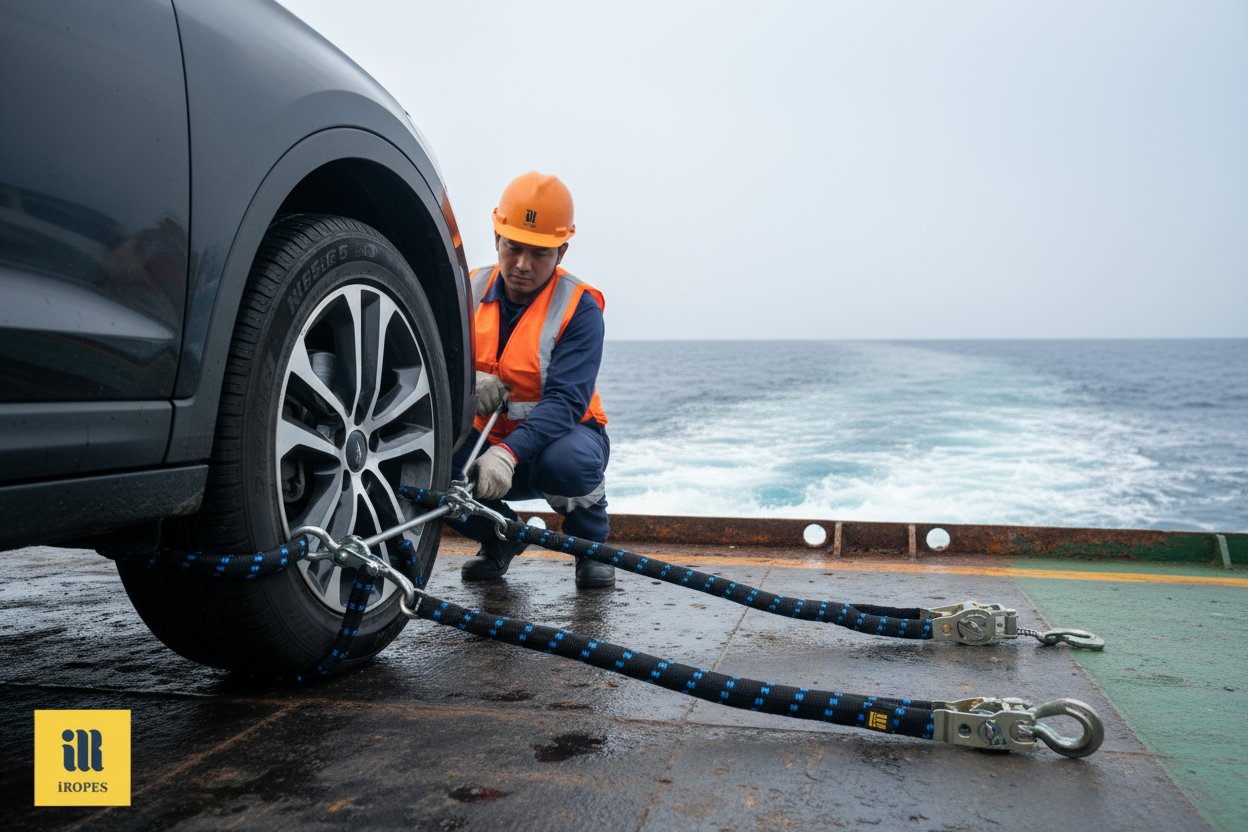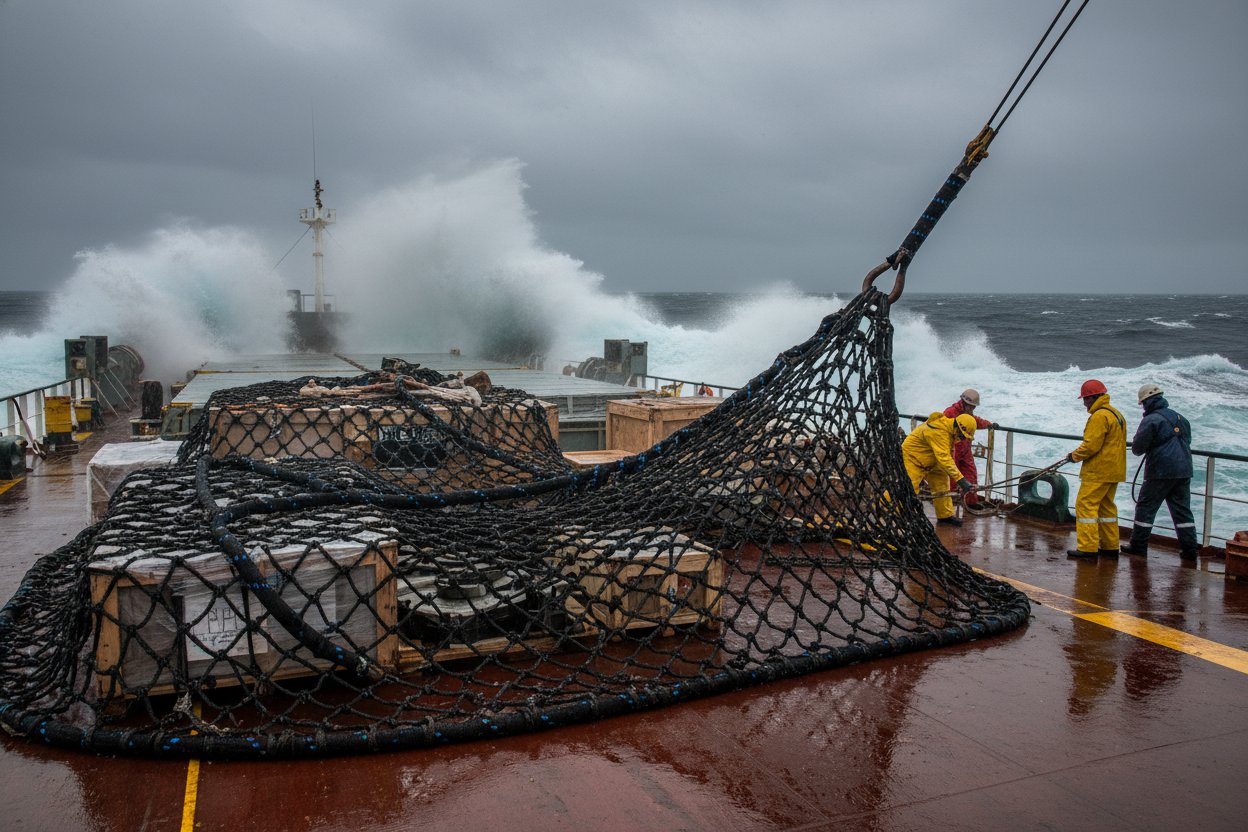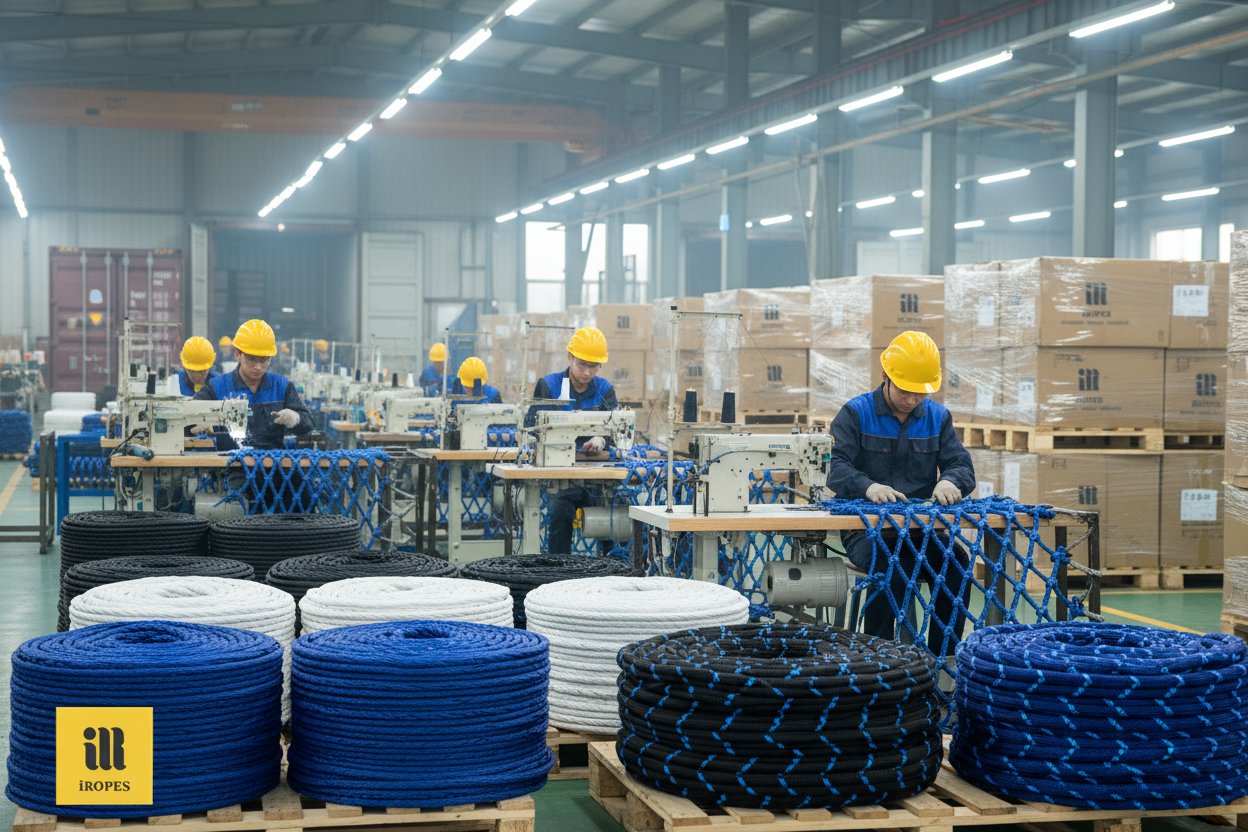Wheel nets outperform traditional cargo slings by preventing 50% more slippage in load stability during rough seas—thanks to targeted tyre grips and marine-grade materials that maintain their Working Load Limit (WLL) without the 20% wet-condition drop-off common in slings. iRopes delivers these innovations to safeguard your marine cargo effortlessly.
Master marine securing in 8 minutes: Discover measurable wins
- ✓ Achieve 50% less slippage on wheeled vehicles via precision tyre cradling, solving uneven load shifts in waves
- ✓ Boost WLL retention to 100% with corrosion-resistant UHMWPE, eliminating sling degradation for safer lifts
- ✓ Slash setup time by 40% through adjustable ratchets and hooks, acquiring faster port operations skills
- ✓ Unlock custom fits via iRopes OEM services, tailoring dimensions to your fleet for branded, compliant solutions
You've relied on cargo slings for years, assuming they'd handle sea swells just fine—yet they tangle and weaken under spray, risking your entire load. What if wheel nets, with their wheel-hugging design, flip that script by distributing force precisely where tyres meet the deck? Dive in to uncover the counter-intuitive material choices and installation tweaks that make iRopes' versions not just smarter, but indispensable for your next voyage.
Understanding Wheel Nets: Advanced Securing for Wheeled Equipment at Sea
Imagine you're on a bustling port deck, waves crashing nearby, and you've got a fleet of vehicles to load onto a transport vessel. Traditional straps might slip under the sway of the sea, but wheel nets change that game entirely. These specialized tools are designed specifically to cradle and secure the wheels of cars, trucks, or heavy machinery during marine transport, ensuring everything stays put no matter how rough the conditions get. This makes them indispensable for anyone dealing with wheeled equipment at sea.
A wheel net, at its core, is a robust webbing system that loops around vehicle tyres to prevent rolling or shifting. Unlike general-purpose cargo straps, it distributes weight evenly across the wheel base, which is crucial when ships pitch and roll. This targeted load distribution is key for logistics professionals handling everything from construction gear to luxury autos across the high seas.
- Side-mount wheel nets - These attach along the side of the wheel, ideal for flatbed trailers or vessel decks where space is tight; they're great for sedans or vans on car carriers.
- Basket configurations - Fully encircling the tyre like a hammock, these suit heavier loads like trucks or ATVs, providing all-around support during lifts or onboard securing.
- Adjustable variants - Featuring extendable straps, these adapt to different tyre sizes, making them versatile for mixed fleets on vehicle transport vessels.
One standout aspect is their build quality for harsh saltwater exposure. Made from marine-grade polyester or even UHMWPE—ultra-high-molecular-weight polyethylene, a super-tough fibre that's lightweight yet incredibly strong—these nets resist corrosion and UV damage that would chew through lesser materials. Adjustable webbing lets you cinch them tight without over-stressing the load. At iRopes, we ensure high Working Load Limits (WLL), which often exceed 10,000 pounds per pair, far surpassing what you'd get from basic slings in wet conditions.
In port cargo operations, wheel nets shine during loading phases, where cranes hoist vehicles aboard. Onboard, they lock wheels to deck fittings, minimizing movement during voyages. Choosing the right one boils down to your vehicle's specifics: for a compact car, opt for a narrower side-mount with a 5,000-pound WLL; heavier machinery might need a basket style rated at 10,000 pounds or more. Consider tyre diameter and total weight—always match the net's capacity to avoid risks.
What sets wheel nets apart from a cargo net lifting sling? While slings are fantastic for hoisting irregular bundles via their mesh design, they don't grip wheels precisely. This can lead to uneven pressure and potential slippage at sea. Wheel nets, by contrast, focus load distribution right where it matters—around the tyre's contact points—reducing stress points and enhancing stability in dynamic environments like rolling waves.

Have you ever watched a vehicle slide inches during a sudden swell? That's the nightmare wheel nets eliminate, offering peace of mind through their tailored engineering.
The Versatility of the Wheel Net in Marine Vehicle Transport
That peace of mind from tailored engineering becomes even more vital when you consider the unpredictable nature of marine travel. Building on how wheel nets provide targeted support for wheeled equipment, their real strength lies in adapting to the demands of vehicle transport across oceans and rough ports. Whether you're hauling cars on a roll-on/roll-off ship or securing trucks during a stormy crossing, these tools offer flexibility that keeps operations smooth and safe.
Getting a wheel net installed right isn't complicated, but doing it properly can make all the difference in preventing mishaps. Start by positioning the vehicle squarely on the deck, ensuring tie-down points align with the ship's fittings. Loop the net around the tyre, using the ratchet to tension the webbing evenly—this distributes force without pinching the rubber. For hooks, J-hooks work best on wheel rims, while flat hooks secure to underbody anchors; always double-check for slippage by giving a firm tug. These steps, when followed, lock everything in place against the constant motion of waves, far better than relying on loose chains that might rattle free.
- Position vehicle and inspect net for wear before attachment.
- Wrap webbing around tyre base, threading through ratchet or hook points.
- Tighten gradually while monitoring load balance to avoid uneven stress.
- Secure secondary points like chassis hooks for added stability.
Compared to traditional cargo slings, wheel nets deliver a superior hold on tyres, which cradle the load rather than just wrapping around it. This means less chance of vehicles shifting during heavy rolls, cutting down injury risks and damage in turbulent seas—imagine avoiding a costly scrape on a high-end SUV just because the grip held firm. Their design also speeds up loading, possibly saving hours at busy ports where every minute counts.
Performance hinges on smart material picks, especially in salty, sun-baked marine spots. Polyester stands out for its affordability and solid UV resistance, holding up without fraying after months exposed to elements. Switch to UHMWPE if you need something lighter yet tougher against corrosion—it's like choosing a raincoat that never wets through, ideal for extended voyages where weight matters for fuel efficiency. These choices ensure the net performs reliably, without the quick breakdown you'd see in standard fabrics.

At iRopes, we take this versatility further with customization that fits wholesale demands like a glove. Need longer straps for oversized tyres or reinforced fittings for defence-grade trucks? Our team tweaks dimensions and adds branded elements, all while keeping costs competitive for bulk orders. This tailored approach means your fleet stays protected exactly how you need it, without generic compromises.
Limitations of Cargo Net Lifting Sling in Harsh Sea Conditions
Building on the precise fit that makes wheel nets so reliable for your fleet's protection, it's worth examining why cargo net lifting slings—those versatile meshes for hoisting all sorts of odd-shaped loads—struggle when the ocean turns unforgiving. You've probably seen them in action at ports, draping over crates or machinery before a crane swing. But at sea, where saltwater sprays and relentless motion test every piece of gear, these slings reveal their vulnerabilities, especially next to the targeted hold of a wheel net.
A cargo net lifting sling typically features a grid of knotted or woven webbing, often in polyester or nylon. It is designed to cradle irregular cargo like pipes, barrels, or equipment bundles. Mesh sizes vary from tight 5-centimetre squares for small items to larger 30-centimetre openings for bulkier stuff, allowing the net to conform without snagging. The webbing, usually 2.5-5 centimetres wide, connects via perimeter ropes and border ropes reinforced with thimbles or shackles for hook attachments. This setup works fine for static lifts on dry land, but expose it to marine swells, and problems mount quickly.
Out on the waves, the real issues surface. Saltwater soaks in, weakening fibres and dropping the Working Load Limit (WLL) by up to 20% in wet conditions, as moisture adds drag and uneven pull. Poor load distribution means pressure spots where cargo digs into the mesh, risking tears during a roll. And tangling? It's a nightmare; loose ends whip around in the wind, potentially fouling deck gear or even endangering crew. Unlike a wheel net that hugs tyres snugly, these slings shift with every pitch, turning a secure lift into a gamble.
Key Factors Affecting WLL
What Influences Cargo Sling Capacity
Material Degradation
UV rays and salt cause polyester to become brittle over time; after six months at sea, strength can drop 15%, slashing safe loads.
Mesh and Webbing Wear
Abrasion from cargo edges enlarges holes, reducing even spread and overall WLL by uneven stress points.
Compliance Standards
ASME B30.9 requires a 5:1 safety factor; non-compliance in wet use voids ratings, demanding frequent re-certification.
Compliance Challenges
Why Standards Matter at Sea
Environmental Exposure
Corrosion on metal fittings halves effective capacity; inspect for rust to maintain integrity.
Configuration Angles
Vertical lifts demand higher WLL than horizontal; improper angles can cut limits by 50%.
Regular Inspections
Follow removal criteria like cuts over 10% depth; this ensures ongoing compliance and safety.
Customization helps somewhat—you can tweak mesh density for better grip on jagged loads or add UV-coated webbing for longer life—but it still can't rival the precision of wheel nets for wheeled cargo. Those slings spread force broadly across a net's surface, not concentrating it around a tyre's curve like a dedicated wheel net does. For vehicles, this means potential slippage where control matters most, no matter how you adjust the sling's borders.
Think about it: if you're rigging a pallet of spare parts, a cargo net might do the trick. But for cars on a rolling deck, the sling's generalist approach just doesn't cut it against targeted alternatives.

Addressing these gaps calls for manufacturers who integrate smarter designs into their lineup, blending the best of both worlds for safer operations overall. As one such manufacturer, iRopes is dedicated to providing high-quality, customised rope solutions to meet these demands.
iRopes' Custom Solutions: Elevating Safety and Efficiency in Marine Operations
Manufacturers who integrate smarter designs truly bridge those gaps in cargo securing, and that's where iRopes steps in with an approach that prioritizes reliability from the ground up. Our integrated solutions go beyond off-the-shelf options, delivering tailored wheel nets and cargo net lifting slings that adapt to the unique demands of marine work, ensuring your operations run smoother and safer.
At the heart of what we do are our OEM and ODM services, allowing wholesale partners like you to design net configurations that fit exact needs—whether it's reinforcing a wheel net for oversized tyres or adjusting a cargo net lifting sling's mesh for awkward loads in salty air. We handle everything in our ISO 9001-certified facilities, where every stitch and knot meets global standards for strength and safety. Plus, our commitment to intellectual property (IP) protection means your custom ideas stay yours, shielded through non-disclosure agreements and secure processes from concept to shipment. It's this level of detail that turns a standard order into a strategic asset for your business.
Defence Applications
Wheel nets crafted with UHMWPE for lightweight, high-strength hold on military vehicles during naval transports, resisting abrasion from rough decks.
Yachting Uses
Custom cargo net lifting slings using corrosion-resistant polyester to secure tenders or gear on luxury yachts, preventing shifts in swells without adding bulk.
Heavy-Duty Materials
Options like braided UHMWPE cores for superior flex and load handling in extreme marine conditions, extending service life on active vessels.
Safety-Focused Builds
Integrating reflective elements and quick-release fittings to boost visibility and emergency response in low-light or high-stakes scenarios.
To keep these custom pieces performing over time, regular inspections form a non-negotiable part of the routine. Look for signs like cuts deeper than 10% of the webbing width, discoloration from chemical exposure, or stitching that's pulled loose—these signal it's time to retire the item. Maintenance involves rinsing off salt with fresh water after each use, storing in a cool, dry spot away from direct sun to fend off UV breakdown, and logging usage hours for predictive checks. Following these practices not only meets compliance like ASME guidelines but also stretches durability, potentially doubling the lifespan of a wheel net in constant marine duty.
What really sets iRopes apart is our precision craftsmanship, where skilled teams in state-of-the-art plants test every batch for breaking strength and even load spread before it ships. We handle global logistics seamlessly, palletizing orders for direct delivery worldwide, with options for your branding on packaging to streamline your resale. This end-to-end care means wholesale partners get gear that's not just tough, but tuned to elevate efficiency—think fewer delays from failures and more confidence in every voyage.

Ever dealt with a delayed shipment because of subpar gear? Our focus on quality sidesteps that, paving the way for operations that prioritize smart, lasting security at sea.
In the demanding world of marine operations, wheel nets emerge as the superior choice for securing wheeled equipment on vehicle transport vessels and during port cargo operations. Unlike the traditional cargo net lifting sling, which struggles with tangling, poor load distribution, and reduced working load limits in wet, rough seas, a wheel net offers precise grip around tyres through adjustable webbing and marine-grade materials like UHMWPE or polyester. This targeted construction ensures even pressure, minimising shifts and enhancing safety, while iRopes' OEM/ODM services allow custom configurations for dimensions, fittings, and branding to meet wholesale needs.
By prioritising these advanced securing techniques and quality standards, wheel nets not only outperform slings in versatility and durability but also streamline efficiency for defence, yachting, and industrial applications. If you're ready to optimize your cargo handling with tailored solutions that protect your fleet amid ocean swells, personalised guidance from iRopes can elevate your operations further.
Discover Custom Wheel Net Solutions for Your Marine Needs
For those seeking more personalised assistance with wheel net designs or cargo securing strategies, the inquiry form above connects you directly to our experts at iRopes. Let's collaborate to ensure your marine transport is safer and more efficient.